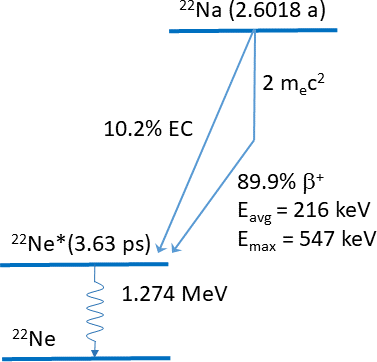The radioactive isotope 22Na decays into the stable 22Ne isotope either via direct positron emission (0.055% probability, end point energy 1821.2 keV, average energy 835 keV) or via positron emission (89.9 % probability, end point energy 546.67 keV, average energy 216 keV) into the first excited 2+ state in 22Ne. The excited state (promptly) decays by emitting a 1274 keV gamma-ray which can be used as a start signal for positron annihilation lifetime studies. Electron capture competes with the β+ decay and it has a 10.1 % probability.
The decay from the 3+ ground state of 22Na to the 2+ excited state in 22Ne is an allowed Gamow-Teller transition with πiπf = 1, while the 22Na 3+ to 22Ne 0+ ground state transition is twice forbidden.
Widely used nuclear data bases such as NNDC state an annihilation radiation probability of 179.91 % (2*89.9 % + 2*0.055 %) for 511 keV photons. However, a non-zero contribution from 3-gamma decays of ortho-Positronium (o-Ps) reduces this fraction. o-Ps forms in porous media or at the surface of materials in contact with the radioisotope leading to a gamma-ray energy distribution which is continuous with a maximum at 511 keV energy. The 3-gamma to 2-gamma ratio can be used to quantify the porosity of the materials.

